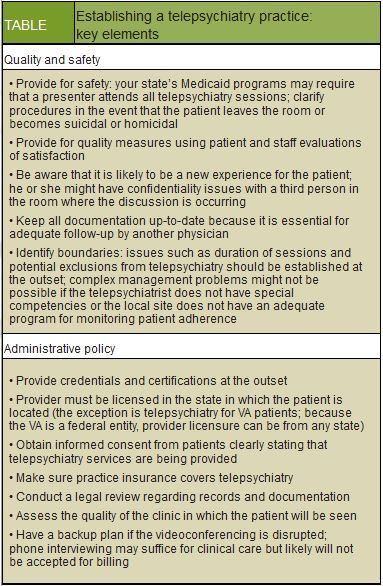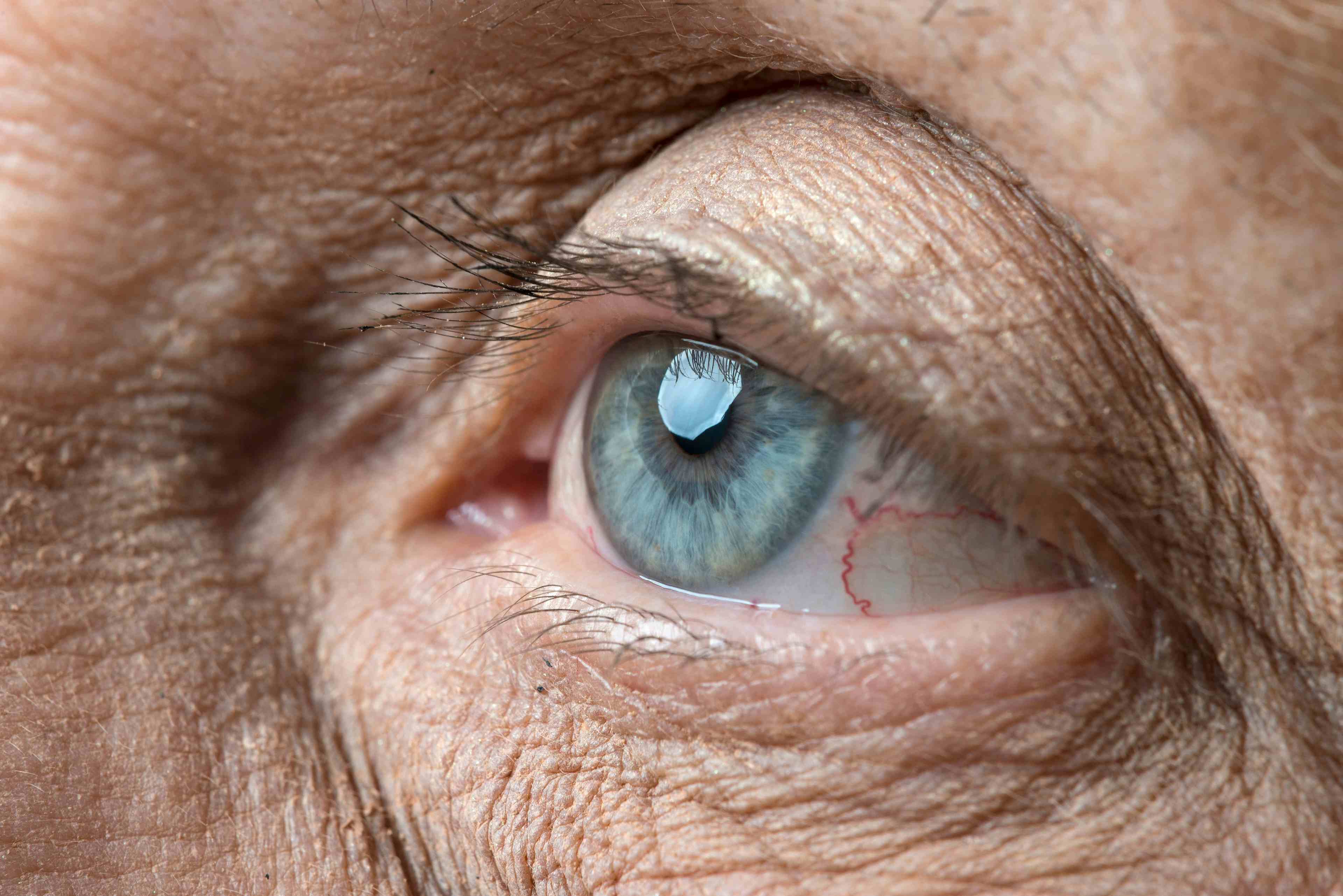Publication
Article
Psychiatric Times
Rural Telepsychiatry: The Future Is Bright
Author(s):
Various populations of patients can benefit from telepsychiatry. The goal is not to replace local mental health resources but to enhance existing capabilities. This article articulates successful interventions as well as topics to consider when developing a telepsychiatry service.
Table

Telepsychiatry has the advantage of providing psychiatric care in otherwise difficult to reach or unlikely locations. In its early development, telepsychiatry provided services to military troops on the front lines, personnel on ships and oil rigs, and patients in rural and/or frontier sites. Our colleagues in Alaska, Canada, and Nebraska were early promoters of telemedicine, and although there were advantages to this technique, there were also challenges-not unlike those we now face.1-3 And there are additional challenges to rural practice. Rural health disparities include physician shortages and higher suicide rates, more poverty, and more methamphetamine use with subsequent hospital admissions.4 The mental health needs and shortage of physicians make a compelling case for telepsychiatry.
Various populations of patients can benefit from telepsychiatry. Access to subspecialty clinics, such as those for children and adolescents or for geriatric patients, may be particularly useful. A commitment to improve services for those with severe and persistent psychiatric disorders can make a significant difference in patient care.
The goal is not to replace local mental health resources but to enhance existing capabilities. Developing 2-way learning between clinicians in a rural community and those from an urban area provides a useful perspective with greater understanding of the issues faced by both populations. Urban clinicians benefit by learning about specific problems in the rural community (eg, lack of services for eating disorders), and the rural clinicians may become more familiar with approaches to treatment of children and adolescents. The effective model emphasizes mutual learning.
With advances in technology, patients in difficult to reach areas can receive care analogous to that provided in urban settings. Although access to specialized care is an important improvement, providers should be aware of specific requirements for its development and implementation.
This article articulates successful interventions as well as topics to consider when developing a telepsychiatry service.
Care integration: logistics
Ultimately, the goal is to be able to integrate telepsychiatry patients into a regular clinic schedule. A patient may be seen in the clinic followed by a telepsychiatry session, where the flip of a video camera switch allows remote access to a patient.
Identifying a suitable area in which to work remotely is one of the early steps in setting up a telepsychiatry practice. Decide which patients you can competently serve. Collaborating with a reliable rural clinic where the patient resides is an important step when considering working remotely with patients.
We are always concerned with issues of confidentiality-working with someone remotely increases the need for data security. An effective system requires a Health Insurance Portability and Accountability Act (HIPAA)-compliant link for the transmission of secure health care information. Early involvement of an informational technology expert to assist with the appropriate computer setup is crucial.
A decision needs to be made about how the patient is billed. Will he be billed directly? Or will you bill his mental health insurance provider, using telepsychiatry billing codes? In Nebraska, where we practice, Medicaid regulations require that the rural clinic provides a “presenter” (an appropriately trained staff member) who is available during the session (regulations vary by state and telepsychiatry providers need to check their state’s regulation). This is not a requirement for other insurance plans but does provide an important consideration for patient safety in case of emergencies. Since telepsychiatry billing is in a state of flux, it would be important to check with the insurance companies that provide reimbursement in the provider’s area.
Local wrap-around services should be researched by the clinician and the ability to access them should be clarified to provide the best care possible. Determine how documentation is completed beforehand-avoid the time-consuming process of documenting in 2 separate charting systems.
Finally, determine who will be responsible for direct, ongoing patient care-you or the patient’s primary care physician (PCP). One of the best uses of psychiatric expertise is to consult on “difficult cases” that have been managed by the PCP. Open communication between consulting psychiatrists and PCPs will result in better patient outcomes.
To establish a telepsychiatry system, you do not have to “reinvent the wheel.” The American Telemedicine Association special interest group in mental health has developed a guide for establishing a credible telepsychiatry program. This 21-page guideline (May 2013) provides specific and useful technical requirements for the provision of mental health services.5
Given the initial challenges of establishing a new system, a mentor who currently provides telepsychiatry can be an invaluable resource. The elements needed for successful implementation may seem tedious but are essential for a smooth beginning. The Table summarizes the key elements that can ease the process of setting up a telepsychiatry practice. The tasks are divided into a quality and safety section and an administrative policy section.
Patient presentations
Several case vignettes that include fictionalized patient presentations provide relevant examples. The first vignette emphasizes the importance of collaboration between the telepsychiatrist, parents, schools, and PCPs that can significantly enhance outcomes for patients who are difficult to treat because of intolerance to common medications.
CASE VIGNETTE
At age 10, Evan was referred to a telepsychiatry clinic for evaluation of poor attention, anxiety, and adverse effects of medication. He had received a diagnosis of ADHD at age 8. Initially, 5 mg of dexmethylphenidate was prescribed for ADHD, which resulted in his “appearing like a zombie.” His father discontinued the drug. A switch to 10 mg of amphetamine mixed salts caused suicidal ideations. At the initial visit with the telepyschiatrist, ADHD combined type and anxiety NOS (not otherwise specified) were diagnosed on the basis of parent and teacher rating scales and clinical interview. Evan was referred for therapy, and atomoxetine was started, which also caused suicidal ideation. He was switched to 18 mg of methylphenidate, which resolved his symptoms well, with no adverse effects.
Evan was intrigued by the video setup and excited to be on camera. He interacted easily with the telepsychiatrist through the video connection and seemed unaffected by the presenter in the room. He was monitored every 2 months with telepsychiatry and phone calls. The PCP was contacted by phone to review the assessment and treatment plan, and notes from telepsychiatry sessions were sent. After 6 months of stability, Evan’s care was transferred back to his PCP.
The next vignette presents a complicated case with multiple environmental factors that influence the patient’s symptoms. The patient had been in a residential treatment center and discharged with medications. The PCP was uncomfortable with prescribing without a reevaluation. The instability in symptoms required frequent follow-up from the telepsychiatrist until the patient’s social situation and symptoms improved. At that time, the PCP felt comfortable with monitoring with an annual reevaluation by the telepsychiatrist.
CASE VIGNETTE
The telepsychiatrist’s intake of 11-year-old Peter revealed depression, severe anger, animal cruelty, and psychotic symptoms. The diagnosis was mood disorder NOS with psychotic features. Treatment was started with risperidone 0.25 mg twice daily. In-home therapy was increased from twice monthly to every week.
By the next appointment, many symptoms had resolved, although Peter was still mildly depressed and had trouble sleeping. Mirtazapine 7.5 mg was added to the treatment regimen. Although most symptoms resolved with this regimen, he had ongoing difficulties with respecting authority. With input from a school teleconference, an effective behavior plan was created. In-home therapy revealed an aunt’s physical abuse, and once his aunt was removed from the home, additional symptoms resolved.
Peter was closely monitored throughout treatment with telepsychiatry. He had no difficulty with using the video connection to speak with the psychiatrist. His mother was also quite comfortable with the telepsychiatrist. Once he had symptom remission, care was transferred to his PCP. The telepsychiatrist reviewed the assessment and treatment plan over the phone with the PCP and sent all treatment notes. Follow-up included visits with the PCP every 3 months and a yearly telepsychiatry session, with the goal of weaning him off one or both of his medications.
Effectiveness and diagnostic accuracy are important issues in telepsychiatry. By having a mixed model of telepsychiatry combined with visits for direct observation, the clinician can determine whether there are significant differences between diagnostic impressions. In the future, improved abilities to adjust the camera to view various aspects of the patient and improved image resolution may minimize the need to do a face-to-face examination.
CASE VIGNETTE
In her 50s, Miriam suffers from schizophrenia and is vulnerable to becoming destabilized by negative comments. She has benefited from the opportunity to have supportive discussions during her half-hour, once-monthly telepsychiatry visits. She likes talking with the psychiatric resident and attending the telepsychiatry sessions.
During a face-to-face visit with the psychiatrist for an AIMS (abnormal involuntary movement scale) evaluation, a further assessment of her symptoms was done, which showed results similar to those of the telepsychiatric evaluation.
The telepsychiatry and face-to-face diagnostic impressions of her psychopathology were the same. The ability to do AIMS testing and look closely for involuntary movements was improved by the face-to-face clinical visit. Looking for problems in gait was better accomplished by the close observation of a direct examination.
Summary
Telepsychiatry has grown substantially since its inception in the 1950s, with improved rural access through advancements in technology. The decreased costs of technology and data transmission have significantly advanced telepsychiatry. The access potential for telepsychiatry is clear and may expand with the use of mobile devices. However, underfunding of telepsychiatry programs has resulted in a series of “start and stop” experiences, with initial success followed by the termination of the program after service grants ended. An effective business model needs to address adequate insurance coverage, grant funding, and support for initial costs that allows durable provision of services over a period of years.
Training more dedicated practitioners and better insurance reimbursement for telepsychiatry services will broaden its availability and benefit patients. Telepsychiatry training in residency and during fellowships is an important step toward the increased number of trained practitioners.
Similar clinical and management issues in providing competent care for different age-groups are present in a general clinic as well as in a telepsychiatry clinic. There needs to be heightened concerns for preserving confidentiality and safety of the patients. The psychiatrist will need an initial period of flexibility to manage the inevitable shortcomings of an electronic system and occasional system failures. Our experience has been a general improvement in the reliability of videoconferencing; however, a backup plan that includes telephone calls and face-to-face meetings needs to be in place.
Although inclusion and exclusion criteria for psychotherapy with telepsychiatry still needs to be developed, supportive therapy is possible with telepsychiatry. The concerns about confidentiality in psychotherapy may well be overstated. If the trust issues about confidentiality of information can be resolved (eg, guarantee that none of the interviews are recorded without the patient’s permission), patients may be open to discussing intimate life issues and participating in active therapeutic discussions.
Editor’s note: This article was published online, ahead of print, and was associated with the August 2013 Special Report on August 15, 2013. It has since been published in the November 2013 print issue of Psychiatric Times, as part of the Trends in Psychiatry (Part 2) Special Report.
Disclosures:
Dr Daughton is Assistant Professor of Child Psychiatry at the University of Nebraska Medical Center, Omaha. She has conducted telepsychiatry clinics for children and adolescents. Dr Greiner is Professor of Psychiatry at the University of Nebraska Medical Center. He has conducted telepsychiatry clinics for adult and geriatric patients and instructed residents in telepsychiatry. He is a member of the American Telepsychiatry Association. Dr Daughton reports that she has received grant support from Novartis; Dr Greiner reports that he has no conflicts of interest concerning the subject matter of this article.
References:
1. Bashshur RL, Shannon GW. History of Telemedicine: Evolution, Context, and Transformation. New Rochelle, NY: Mary Ann Liebert, Inc Publishers; 2009.
2. Darkins AW, Cary MA. Telemedicine and Telehealth: Principles, Policies, Performance, and Pitfalls. New York: Springer Publishing Co; 2000.
3. Wittson CL, Affleck DC, Johnson V. Two-way television in group therapy. Ment Hosp. 1961;12:22-23.
4. Rural assistance center (RAC). http://www.raconline.org. Accessed July 3, 2013.
5. American Telemedicine Association. http://www.americantelemed.org. Accessed July 3, 2013.
















